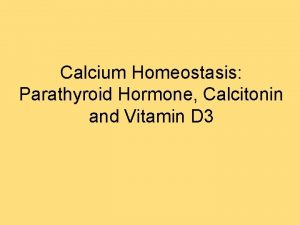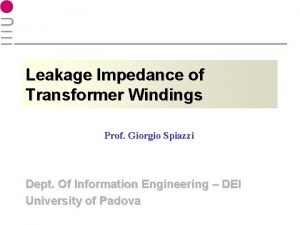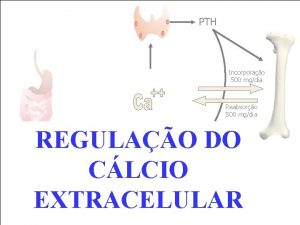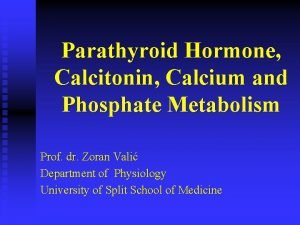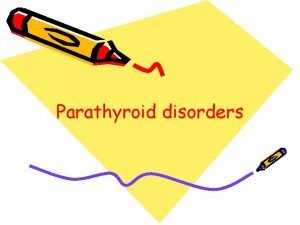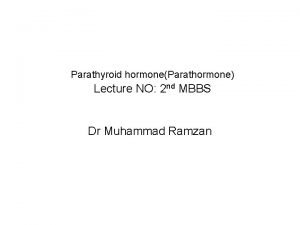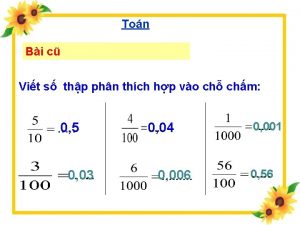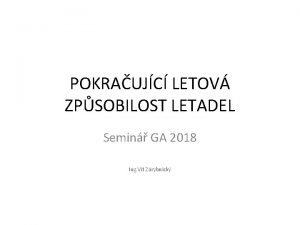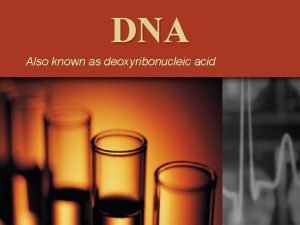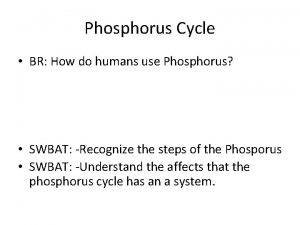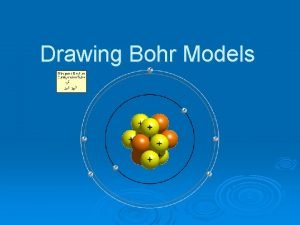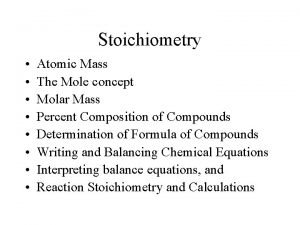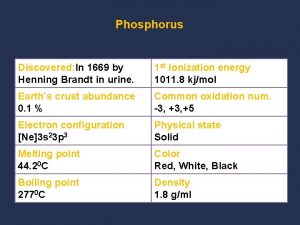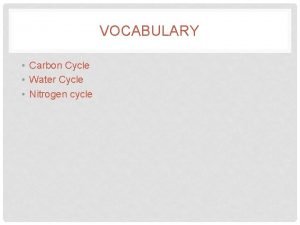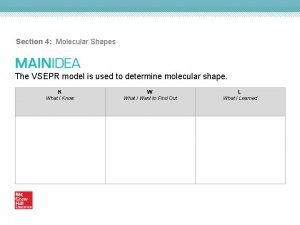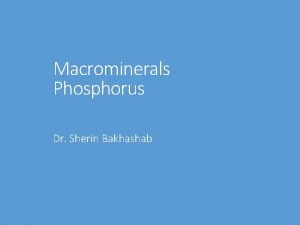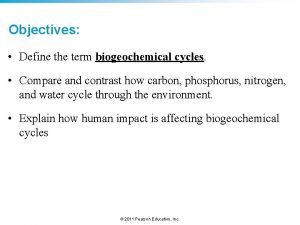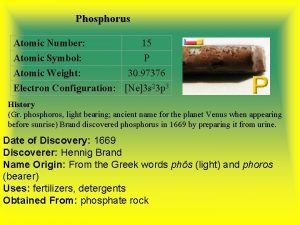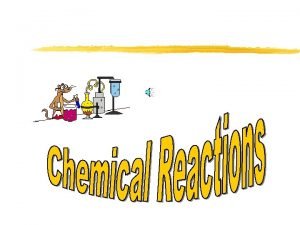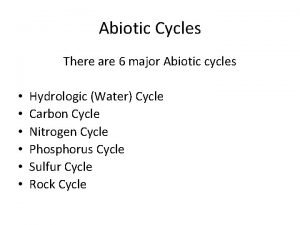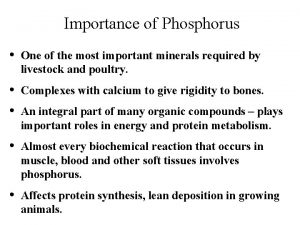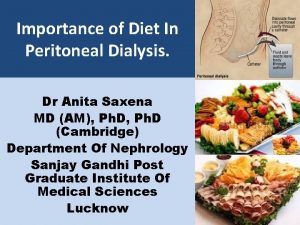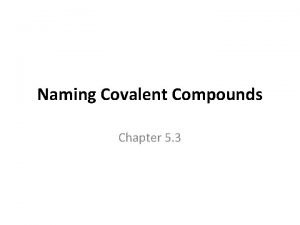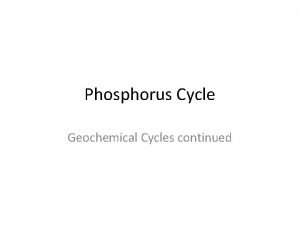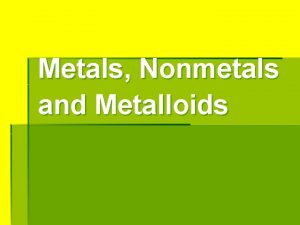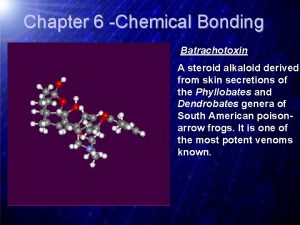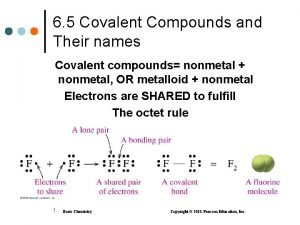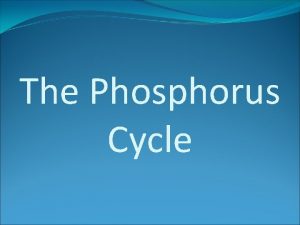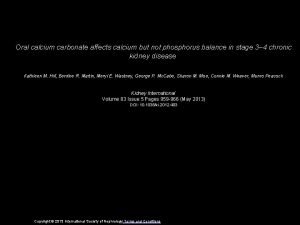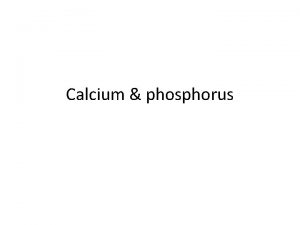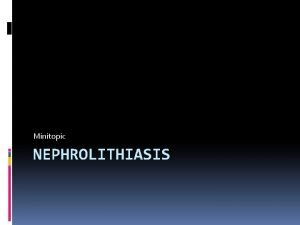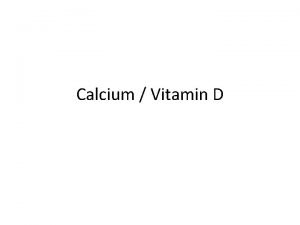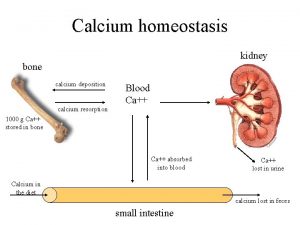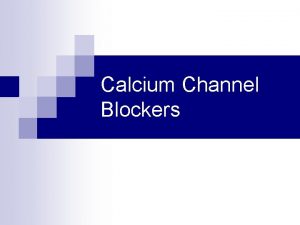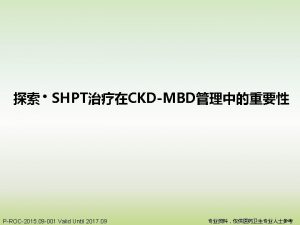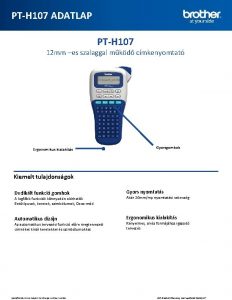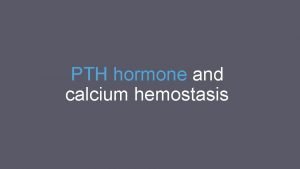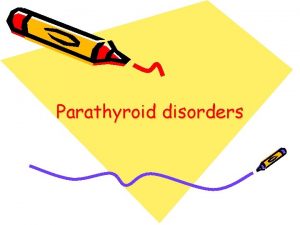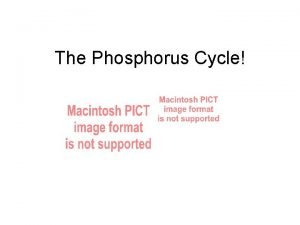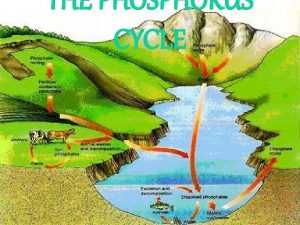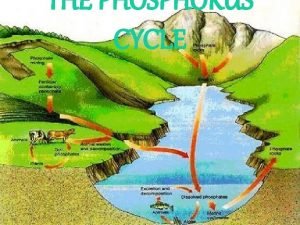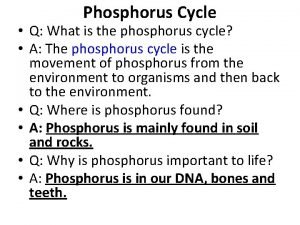Ca PO 4 PTH VIT D Calcium Phosphorus

















































































- Slides: 81

Ca++, PO 4, PTH & VIT D Calcium, Phosphorus & Vitamin D In Chronic Renal Failure By Dr. Rick Hiller

Phosphorus Measurement and Balance • Normal concentration between 2. 5 and 4. 5 mg/dl. • 85% of total body stores are contained in bone (hydroxyapatite), 14% is intracellular, and 1% extracellular.

Phosphorus Measurement and Balance • 70% of the extracellular phosphorus is organic (phospholipids) and the remaining 30% is inorganic. • 15% of the inorganic is protein bound; the remaining is complexed with sodium, magnesium, or calcium or circulates as free monohydrogen or dihydrogen forms. • This freely circulating phosphorus is what is measured.

Phosphorus Measurement and Balance • 2/3 of ingested phosphorus is excreted in urine; the remaining in stool. • Foods high in phosphorus are also high in protein. • Three organs are involved in phosphate homeostasis: intestine, kidney, and bone. • Major hormones involved are Vit. D and PTH

Phosphorus Homeostasis • 60 -70% of dietary phosphorus is absorbed by the GI tract via: – Passive transport – Active transport stimulated by calcitriol and PTH • Antacids, phosphate binders, and calcium bind to phosphorus, decreasing the free amount available for absorption

Phosphorus Homeostasis • Inorganic phosphorus is freely filtered by the glomerulus. • 70 -80% is then reabsorbed in the proximal tubule. The remaining is reabsorbed in the distal tubule. • Phosphorus excretion can be increased primarily by increasing plasma phosphorus concentration and PTH.

Phosphorus Homeostasis • Phosphorus excretion can also be increased to a lesser degree by volume expansion, metabolic acidosis, glucocorticoids, and calcitonin. • This regulation occurs in the proximal tubule via the sodium-phosphate cotransporter.


Calcium Measurement and Balance • Normal Concentration between 8. 5 and 10. 5 mg/d. L • Serum levels are 0. 1 -0. 2% of extracellular calcium; this is only 1% of total body calcium • The remainder of total body calcium is stored in bone.

Calcium Measurement and Balance • Ionized calcium is physiologically active and is 40% of total serum calcium. • Non-ionized calcium is bound to albumin, citrate, bicarbonate, and phosphate • Ionized calcium can be corrected from total calcium by adding 0. 8 mg/d. L for every 1 mg decrease in serum albumin below 4 mg/d. L

Calcium Measurement and Balance • PTH regulates serum ionized calcium by – Increasing bone resorption – Increasing renal calcium reabsorption – Increasing the conversion of 25(OH)D to 1, 25(OH)2 D in the kidney which increases the GI absorption of calcium


Calcium Measurement and Balance • Decreased PTH and Vit. D maintain protection against calcium overload by increasing renal excretion and reducing intestinal absorption.

Calcium Homeostasis • Calcium absorption primarily occurs in the duodenum through Vit. D dependent and Vit. D independent pathways. • 60 -70% of calcium is reabsorbed passively in the proximal tubule, with another 10% reabsorbed in the thick ascending limb


Calcium-Sensing Receptor • Expressed in organs controlling calcium homeostasis: parathyroid gland, thyroid C cells, intestines, and kidneys. • Expression is regulated by 1, 25(OH)2 D

Synthesis and Measurement of Vitamin D • Vitamin D 3 is metabolized in the skin from 7 -dehydrocholesterol • Vitamin D 2 (ergocalciferol) is obtained in the diet from plant sources • Vitamin D 3 (cholecalciferol) is also obtained in the diet from animal sources

Synthesis and Measurement of Vitamin D • In the Liver, Vitamins D 2 and D 3 are hydroxylated to 25(OH)D (calcidiol) • Calcidiol then travels to the kidney where it is converted to 1, 25(OH)2 D


Physiologic Effects of Vitamin D • Facilitates the uptake of calcium in the intestinal and renal epithelium • Enhances the transport of calcium through and out of cells • Is important for normal bone turnover

Physiologic Effects of Vitamin D • Elevated serum PTH increases the hydroxylation of Vitamin D in the kidney • This causes a rise in serum calcium and feeds back to the parathyroid gland decreasing PTH secretion



Regulation and Biologic Effects of Parathyroid Hormone • Primary function of PTH is to maintain calcium homeostasis by: – Increasing bone mineral dissolution – Increasing renal reabsorption of calcium and excretion of phosphorus – Increasing activity of renal 1 -α-hydroxylase – Enhancing GI absorption of calcium and phosphorus



Regulation of Parathyroid Hormone • Hypocalcemia is more important in stimulating PTH release • Normal or elevated Calcitriol is more important in inhibiting PTH release

Regulation of Parathyroid Hormone • Increased PTH in Secondary Hyperparathyroidism is due to: – Loss of renal mass – Low 1, 25(OH)2 D – Hyperphosphatemia – Hypocalcemia – Elevated FGF-23


Measurement of PTH • Plasma PTH levels provide: – a noninvasive way to initially diagnose renal bone disease – Allow for monitoring of the disorder – Provide a surrogate measure of bone turnover in patients with CKD


Effects of CKD • Chronic Renal Failure disrupts homeostasis by: – Decreasing excretion of phosphate – Diminishing the hydroxylation of 25(OH)D to calcitriol – Decreasing serum calcium • Leads to Secondary Hyperparathyroidism


Secondary HPT • Initially, the hypersecretion of PTH is appropriate to normalize plasma Ca 2+ and phosphate concentrations. • Chronically, it becomes maladaptive, reducing the fraction of filtered phosphate that is reabsorbed from 80 -95% to 15%

Secondary HPT • Secondary HPT begins when the GFR declines to <60 ml/min/1. 73 m 2 • Serum Ca 2+ and PO 4 levels remain normal until GFR declines to 20 ml/min/1. 73 m 2 • Low levels of calcitriol occur much earlier, possibly even before elevations in i. PTH.

Secondary HPT • Secondary HPT tries to correct: – hypocalcemia by increasing bone resorption – Calcitriol deficiency by stimulating 1 hydroxylation of calcidiol (25 -hydroxyvitamin D) in the proximal tubule

Hypocalcemia • Total Serum Calcium usually decreases during CKD due to: – Phosphate retention – Decreased calcitriol level – Resistance to the calcemic actions of PTH on bone

Hypocalcemia • Potent stimulus to the release of PTH – Increases m. RNA levels via posttranscription – Stimulates proliferation of parathyroid cells • Plays a predominant role via Ca. SR: • Major therapeutic target for suppressing parathyroid gland function




Decreased Vitamin D • Decreases calcium and phosphorus absorption in the GI tract. • Directly increases PTH production due to the absence of the normal suppressive effect of calcitriol • Indirectly increases secretion of PTH via the GI mediated hypocalcemic stimulus

Decreased Vitamin D • Administering calcitriol to normalize plasma levels can prevent or reverse secondary HPT • Calcitriol deficiency may change the set point between PTH and plasma free calcium


Mechanisms by which Phosphate Retention may lead to HPT • Diminishes the renal production of calcitriol • Directly increases PTH gene expression • Hyperphosphatemia, hypocalcemia, and elevated PTH account for ~17. 5% of observed, explainable mortality risk in HD patients with the major cause of death being cardiovascular events


Secondary HPT • If phosphate retention is prevented, then secondary hyperparathyroidism does not occur.

If Secondary HPT is not corrected • Renal Osteodystrophy – Osteitis fibrosa cystica – predominantly hyperparathyroid bone disease – Adynamic bone disease – diminished bone formation and resorption – Osteomalacia – defective mineralization in association with low osteoclast and osteoblast activities – Mixed uremic osteodystrophy – hyperparathyroid bone disease with a superimposed mineralization defect • Metastatic calcification


Renal Osteodystrophy • Serum intact PTH Predicts severity of HPT, but not necessarily bone disease • PTH < 100 pg/m. L – adynamic bone disease • PTH > 450 pg/m. L – hyperparathyroid bone disease and/or mixed osteodystrophy • PTH < 200 pg/m. L – increased risk of fracture

Renal Osteodystrophy • Low serum bone-specific alkaline phosphatase (<= 7 ng/m. L) and a low serum PTH suggests a low remodeling disorder • Elevated alkaline phosphatase (>= 20 ng/m. L) alone or with increased serum PTH (>200 pg/m. L) suggests high turnover bone disease.


Low Bone Turnover • Most patients are asymptomatic • Increased risk of fracture due to impaired remodeling • Increased risk of vascular calcification due to inability of bone to buffer an acute calcium load


Metabolic Acidosis and Bone Mineral Disease • Stimulates physiochemical mineral dissolution buffering excess hydrogen ions • Leads to a gradual decline in bone calcium stores • Stimulates cell-mediated bone resorption via stimulating osteoclastic activity • Alkali therapy can slow progression of uremic bone disease

New Classification of Bone Disease • Developed to help clarify the interpretation of bone biopsy results • Provide a clinically relevant description of underlying bone pathology • Helps define pathophysiology and guide treatment



Vascular Calcification • Cardiovascular disease remains the leading cause of morbidity and mortality in CKD • Disorders of Mineral Metabolism – Accelerated atherosclerosis – Arterial calcification – Increased risk of adverse cardiovascular outcomes and death

Extraosseous Calcification • Calcium phosphate precipitation into joints, arteries, soft tissues, and viscera • Calciphylaxis • When the fraction of reabsorbed filtered phosphate declines to 15%, PTH cannot increase phosphate excretion but does continue to release calcium phosphate from bone

Phosphorus and Calcium in CKD • Hyperphosphatemia brings with it a very high population attributable risk of death • Combination of hyperphosphatemia, hypercalcemia, and elevated PTH accounted for 17. 5% of observed, explainable mortality in HD patients


Vascular Calcification • Late in the disease, fibrofatty plaques protrude into the arterial lumen, leading to a filling defect on angiography • Early in the disease, atherosclerosis can be a circumferential lesion without lumen obstruction


Vascular Calcification • Dialysis Patients have calcification scores that are two-to five fold greater than agematched individuals with normal kidney function and angiographically proven CAD • Dialysis patients have increased arterial calcification (intimal disease and medial layer thickening) in coronary, renal, and iliac arteries.



Post-Renal Transplant Bone Disease • Kidney Transplantation returns patients to CKD and to CKD-MBD. • Disorders of mineral metabolism occur post transplant and include: – Effects of medications – Persistence of underlying disorders – Development of hyperphosphaturia with hypophosphatemia


TREATMENT Secondary Hyperparathyroidism Treatment Options

• Dietary Restriction of Phosphorus • Phosphate Binders (calcium or non-calcium containing) • Vitamin D Analogues • Calcimimetics • Parathyroidectomy

Dietary Phosphate Restriction • 800 – 1, 000 mg per day • Reverses abnormalities of mineral metabolism – Increases plasma calcitriol – Diminishes PTH levels – Improves Ca 2+ intestinal absorption


Phosphate Binders • Limit the absorption of dietary phosphate • Calcium Salts • Non-calcium containing (sevelamer and lanthanum carbonate) • Calcium containing binders should be limited to <1500 mg of elemental calcium per day to keep total calcium intake <2000 mg per day

Phosphate Binders • Vitamin D will increase the intestinal absorption of calcium: calcium containing binders should be reduced accordingly • Patients with low turnover bone disease will deposit excess calcium in extraskeletal sites because their bones cannot take up the calcium.

Vitamin D • • • Ergocalciferol Limit dose of active Vitamin D analogues: Paricalcitol Doxercalciferol Calcitriol Dose limited by hypercalcemia and hyperphosphatemia

VITAMIN D ANALOGUES • Reduce dose of active Vitamin D as PTH levels diminish. • Adjust dose every 4 -8 weeks • Discontinue calcitriol during hypercalcemia • Contraindicated with PTH levels less than 150 pg/ml

Calcimimetics • • • Increase the sensitivity of the Ca. SR Decrease PTH gene expression Increase Vitamin D receptor expression Can reduce plasma PTH by more than 50% Cinacalcet (Sensipar) Limited by hypocalcemia

Treatment Goals in Dialysis Patients • Intact PTH between 150 -300 pg/m. L • Serum Phosphate between 3. 5 -5. 5 mg/d. L • Serum levels of total corrected Calcium between 8. 4 -9. 5 mg/d. L

Treatment Strategy • Reduce Serum Phosphate to normal range • Limit Excessive Calcium Loading • Use Calcimimetic for elevated PTH with Ca>9. 5 • Avoid active Vitamin D analogues and if used, reduce dose as treatment progresses • Prevent progression of parathyroid disease • Maintain bone health and prevent fractures

References • • • Brenner, Barry M. Brenner & Rector’s The Kidney. 8 th Edition. Saunders Elsevier 2008. Pp. 1784 -1809. Rose, Burton D. and Theodore W. Post. Chapter 6 F: Hormonal Regulation of Calcium and Phosphate Balance. Up To Date 2010. Pp. 1 -10. Rose, Burton D. and Theodore W. Post. Chapter 6 G: Calcium and Phosphate Metabolism in Renal Failure. Up To Date 2010. Pp. 1 -8. Qunibi, Wajeh Y. and William L. Henrich. Pathogenesis of Renal Osteodystrophy. Up To Date 2010. Pp. 1 -15. Quarles, Darryl L. Bone Biopsy and the Diagnosis of Renal Osteodystrophy. Up To Date 2010. Pp. 1 -17. Quarles, Darryl L. and Robert E. Cronin. Management of Secondary Hyperparathyroidism and Mineral Metabolism Abnormalities in Dialysis Patients. Up To Date 2010. Pp. 1 -21.
 Du maitre qui m'appelle
Du maitre qui m'appelle Function of calcitonin
Function of calcitonin Dowell curves
Dowell curves Vitamine d et parathormone
Vitamine d et parathormone Mineralização
Mineralização Tropic hormones hypothalamus
Tropic hormones hypothalamus Pth stable coin
Pth stable coin Serum pth
Serum pth Bone fluid
Bone fluid Trosseau sign
Trosseau sign Mechanism of action of parathyroid hormone
Mechanism of action of parathyroid hormone Vyžle vzor
Vyžle vzor Scorbutic gums
Scorbutic gums Thú mỏ vịt được xếp vào lớp thú vị
Thú mỏ vịt được xếp vào lớp thú vị Gsdc vit
Gsdc vit Chính tả gà và vịt
Chính tả gà và vịt Vit i
Vit i 1 con vịt
1 con vịt Vit c c
Vit c c What language is spoken in vietnam
What language is spoken in vietnam Vit standards checklist
Vit standards checklist Viv root word
Viv root word Bc phn
Bc phn Nous on vit la vie jour après jour nuit après nuit
Nous on vit la vie jour après jour nuit après nuit Nese do te mbjellesh per nje vit
Nese do te mbjellesh per nje vit Vyset viset
Vyset viset Be vit
Be vit Vit c c
Vit c c Vit s
Vit s Nazývať príbuzné slová
Nazývať príbuzné slová Nào cảm tạ chúa vì chúa rất nhân từ
Nào cảm tạ chúa vì chúa rất nhân từ 5000 200
5000 200 Tit n
Tit n Words with the root viv
Words with the root viv Vit cc
Vit cc Nayira vit
Nayira vit Nam invest
Nam invest Chuỗi cung ứng coca cola
Chuỗi cung ứng coca cola Vit prefix
Vit prefix Ing. vít zárybnický
Ing. vít zárybnický Vit i
Vit i Synecdoque plastique
Synecdoque plastique Vit group
Vit group Phosphorus-32
Phosphorus-32 How do humans negatively affect the phosphorus cycle
How do humans negatively affect the phosphorus cycle Phosphorus bohr rutherford diagram
Phosphorus bohr rutherford diagram Primary succession comic strip
Primary succession comic strip Stoichiometry mole-mole
Stoichiometry mole-mole What are the physical properties of phosphorus
What are the physical properties of phosphorus Phosphorus cycle
Phosphorus cycle Phosphorus cycle labeled
Phosphorus cycle labeled Phosphorus trihydride shape
Phosphorus trihydride shape Difference between phosphorus cycle and carbon cycle
Difference between phosphorus cycle and carbon cycle Electron configuration of phosphorus orbital diagram
Electron configuration of phosphorus orbital diagram The phosphorus cycle
The phosphorus cycle Bohr model cl
Bohr model cl Functions of phosphorus
Functions of phosphorus Phosphorus cycle pearson education
Phosphorus cycle pearson education Carbon cycle comic strips
Carbon cycle comic strips Denitrification definition
Denitrification definition Chemical equation of phosphorus
Chemical equation of phosphorus Upl ratol
Upl ratol Water cycle pearson education
Water cycle pearson education 15 atomic number
15 atomic number Combustion formula example
Combustion formula example Lagoon phosphorus removal
Lagoon phosphorus removal What is the major abiotic reservoir for phosphorus
What is the major abiotic reservoir for phosphorus Opooop
Opooop Phosphorus cycle
Phosphorus cycle Phosphorus cycle
Phosphorus cycle Di tri tetra penta hexa hepta octa nona deca
Di tri tetra penta hexa hepta octa nona deca High phosphorus foods
High phosphorus foods Naming covalent compounds rules
Naming covalent compounds rules Phosphate in soil
Phosphate in soil Phosphorus color and luster
Phosphorus color and luster Carbon cycle human impact
Carbon cycle human impact Soybean phosphorus deficiency
Soybean phosphorus deficiency Urr hemodialysis
Urr hemodialysis Phosphorus hexachloride lewis structure
Phosphorus hexachloride lewis structure Nitrogen fertilizer example
Nitrogen fertilizer example Phosphorus pentachloride covalent compound formula
Phosphorus pentachloride covalent compound formula Biogeochemical cycle quiz
Biogeochemical cycle quiz

